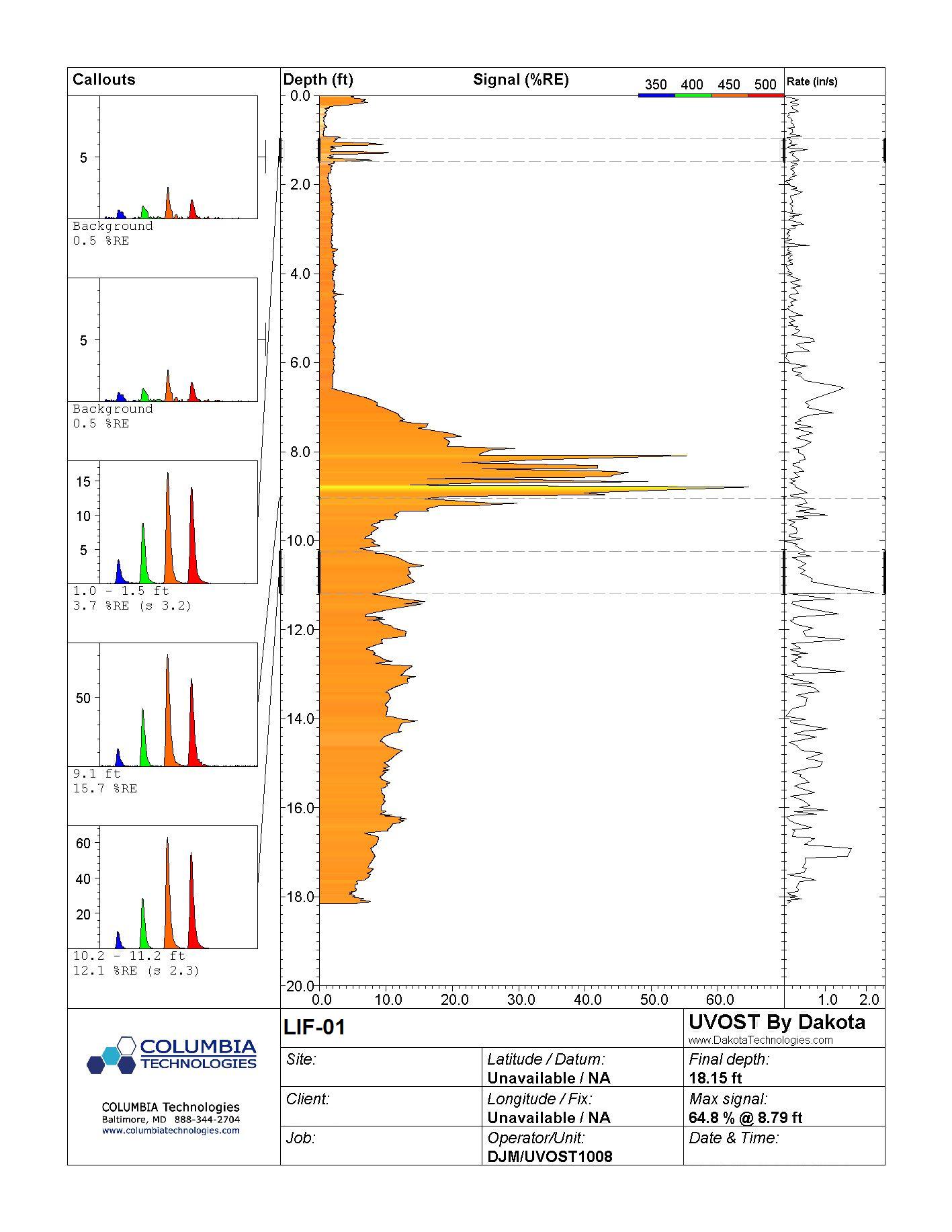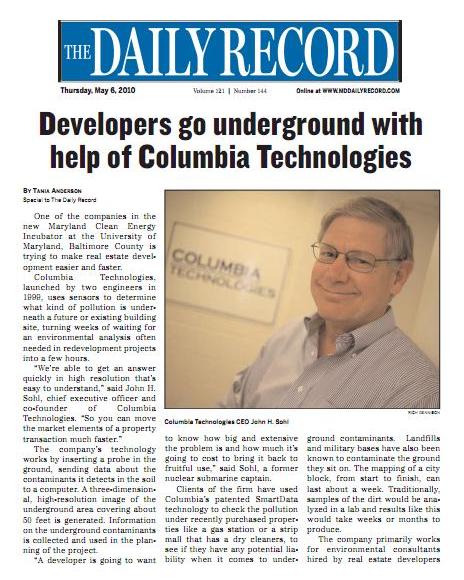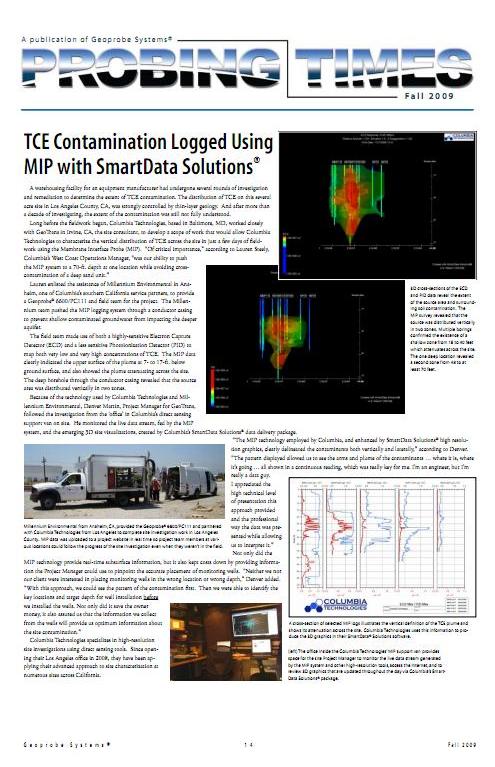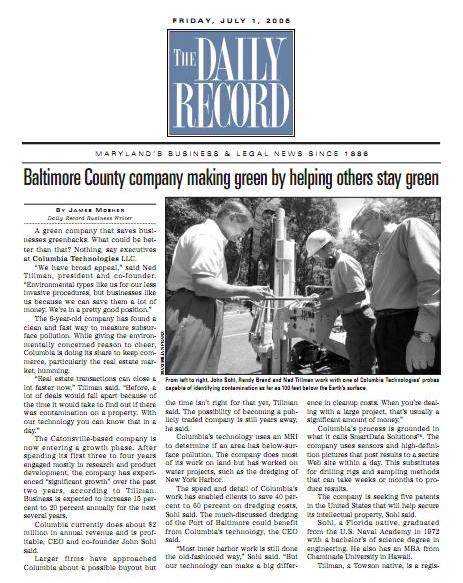Separating NAPL Compounds using LIF/UVOST® Technology
During a recent site characterization in Hawaii using LIF/UVOST® technology COLUMBIA Technologies...

During a recent site characterization in Hawaii using LIF/UVOST® technology COLUMBIA Technologies...

Article originally featured in The Daily Record May 6, 2010 Issue One of the companies in the new...

Article originally featured in the Probing Times, the official newsletter of Geoprobe Systems® Fall...

Article originally featured in The Daily Record July 1, 2005 Issue A green company that saves...
During a recent site characterization in Hawaii using LIF/UVOST® technology COLUMBIA Technologies encountered relatively low levels of petroleum contamination hidden in an usually high background response. This resulted due to the presence of naturally occurring fluorescence materials (likely calcareous sands) in the subsurface at the site. This elevated background fluctuated in response intensity from log to log and often within a single log, making it more difficult to accurately identify residual petroleum contamination responses in the subsurface.
Dakota Technologies, the inventor and manufacturer of UVOST® instrumentation, was able to mathematically separate five different petroleum compound signatures from the background interference. This extended data processing enabled COLUMBIA to more accurately map the residual petroleum concentration in 3D. The subsequent data set correlated well to soil samples selected by the client providing multiple lines of evidence of the extent of the historical petroleum spill.
Tags: High Resolution Site Characterization (HRSC), Laser Induced Fluorescence, LIF, News, UVOST
Article originally featured in The Daily Record May 6, 2010 Issue
One of the companies in the new Maryland Clean Energy Incubator at the University of Maryland, Baltimore County is trying to make real estate development easier and faster.
Columbia Technologies, launched by two engineers in 1999, uses sensors to determine what kind of pollution is underneath a future or existing building site, turning weeks of waiting for an environmental analysis often needed in redevelopment projects into a few hours.
"We're able to get an answer quickly in high resolution that's easy to understand," said John H. Sohl, chief executive officer and co-founder of Columbia Technologies. "So you can move the market elements of a property transaction much faster."
The company's technology works by inserting a probe in the ground, sending data about the contaminants it detects in the soil to a computer. A three-dimensional, high-resolution image of the underground area covering about 50 feet is generated. Information on the underground contaminants is collected and used in the planning of the project.
"A developer is going to want to know how big and extensive the problem is and how much it's going to cost to bring it back to fruitful use," said Sohl, a former nuclear submarine captain.
Tags: COLUMBIA Technologies, John Sohl, News, SmartData Solutions®
Article originally featured in the Probing Times, the official newsletter of Geoprobe Systems® Fall 2009 Issue
Long before the fieldwork began, Columbia Technologies, based in Baltimore, MD, worked closely with GeoTrans in Irvine, CA, the site consultant, to develop a scope of work that would allow Columbia Technologies to characterize the vertical distribution of TCE across the site in just a few days of fieldwork using the Membrane Interface Probe (MIP).
"Of critical importance," according to Lauren Steely, Columbia's West Coast Operations Manager, "was our ability to push the MIP system to a 70-ft. depth at one location while avoiding cross-contamination of a deep sand unit."
Lauren enlisted the assistance of Millennium Environmental in Anaheim, one of Columbia's southern California service partners, to provide a Geoprobe® 6600/PC111 and field team for the project. The Millennium team pushed the MIP logging system through a conductor casing to prevent shallow contaminated groundwater from impacting the deeper aquifer.
Tags: COLUMBIA Technologies, High Resolution Site Characterization (HRSC), Membrane Interface Probe, MIP, SmartData Solutions®
Article originally featured in The Daily Record July 1, 2005 Issue
"We have a broad appeal," said Ned Tillman, president and co-founder. "Environmental types like us for our less invasive procedures, but businesses like us because we can save them a lot of money. We're in a pretty good position."
The 6-year-old company has found a clean and fast way to measure subsurface pollution. While giving the environmentally concerned reason to cheer, Columbia is doing its share to keep commerce, particularly the real estate marketing, humming.
"Real estate transactions can close a lot faster now," Tillman said. "Before, a lot of deals would fall apart because of the time it would take to find out if there was contamination on a property. With our technology you can know that in a day."
The Catonsville-based company is now entering a growth phase. After spending its first three to four years engaged mostly in research and product development, the company has experienced "significant growth" over the past two years, according to Tillman. Business is expected to increase 15 to 20 percent annually for the next several years.
Columbia currently does about $2 million in annual revenue and is profitable, CEO and co-founder John Sohl said.
Tags: COLUMBIA Technologies, John Sohl, News, SmartData Solutions®
© COLUMBIA Technologies, LLC. All Rights Reserved.
HQ 1 Research Court Suite 450-402
Rockville, Maryland USA 20850-6252
Tel +1-888-344-2704 |
Email: info@columbiatechnologies.com
Privacy and Legal | Terms of Service